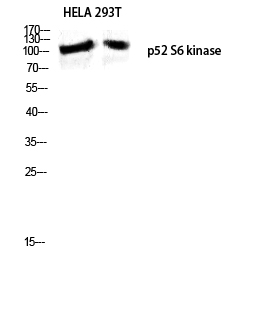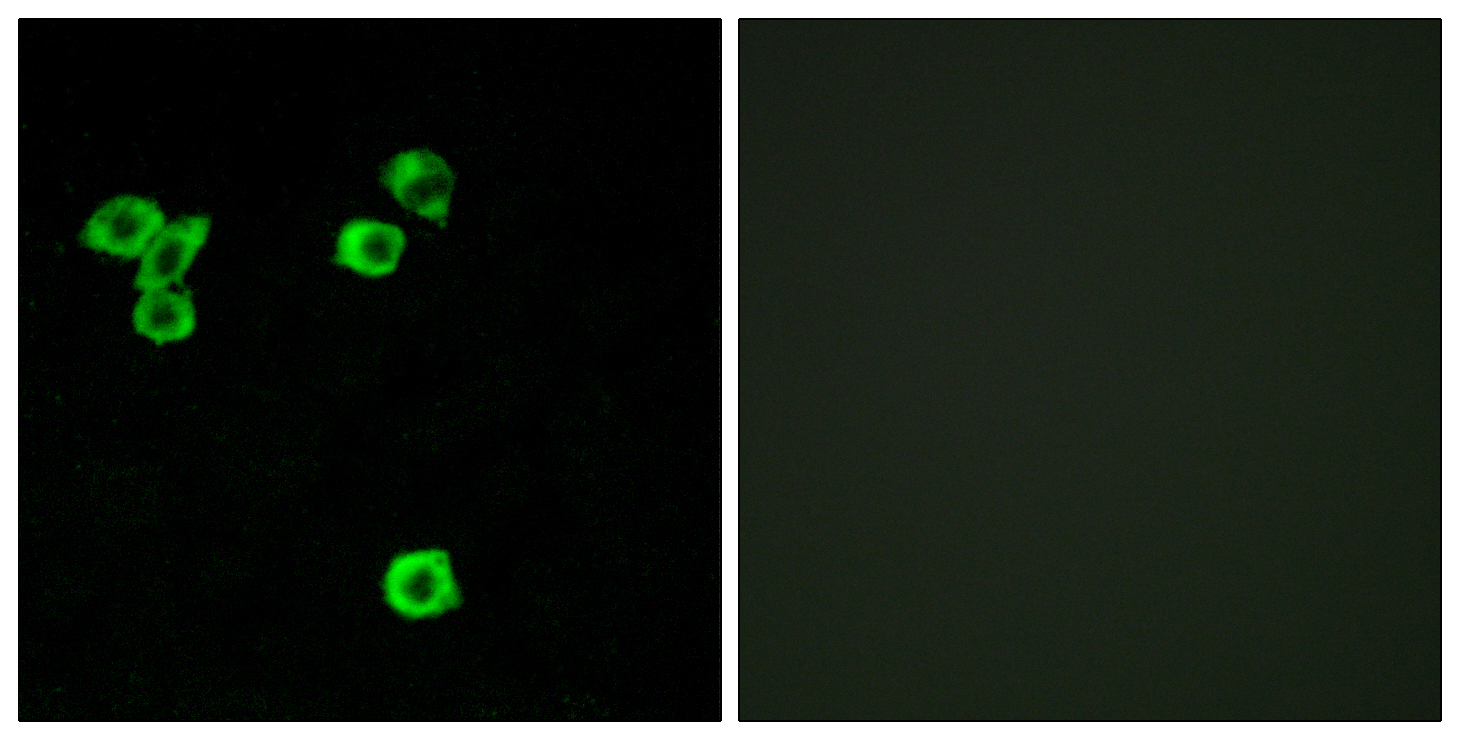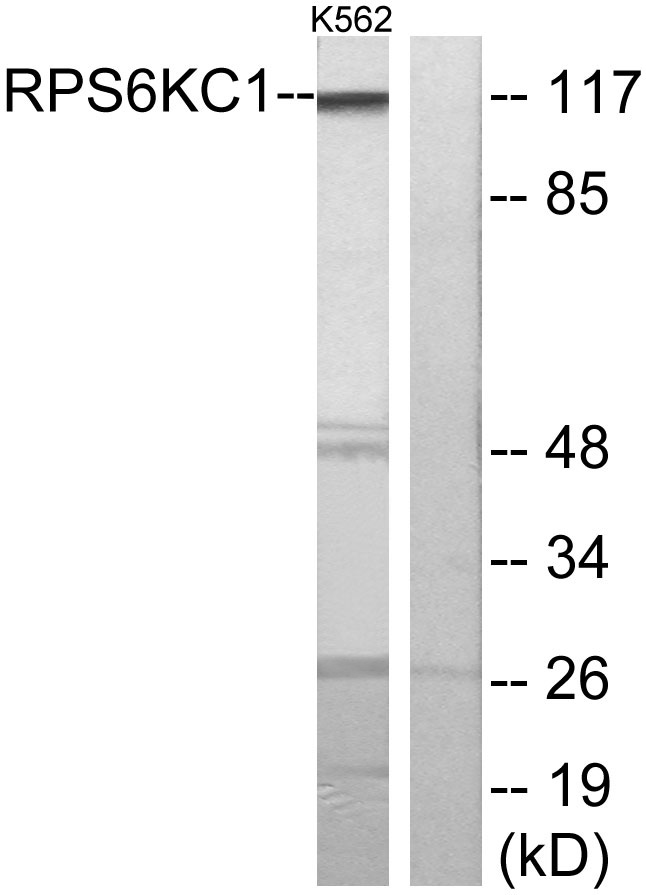- 靶点:
- p52 S6 kinase
- 基因名称:
- RPS6KC1
- 蛋白名称:
- Ribosomal protein S6 kinase delta-1
- Human Gene Id:
- 26750
- Human Swiss Prot No:
- Q96S38
- Mouse Gene Id:
- 320119
- Mouse Swiss Prot No:
- Q8BLK9
- 免疫原:
- The antiserum was produced against synthesized peptide derived from human RPS6KC1. AA range:231-280
- 特异性:
- p52 S6 kinase Polyclonal Antibody detects endogenous levels of p52 S6 kinase protein.
- 组成:
- Liquid in PBS containing 50% glycerol, 0.5% BSA and 0.02% sodium azide.
- 来源:
- Polyclonal, Rabbit,IgG
- 稀释:
- WB 1:500 - 1:2000. IF 1:200 - 1:1000. ELISA: 1:20000. Not yet tested in other applications.
- 纯化工艺:
- The antibody was affinity-purified from rabbit antiserum by affinity-chromatography using epitope-specific immunogen.
- 浓度:
- 1 mg/ml
- 储存:
- -15°C to -25°C/1 year(Do not lower than -25°C)
- 其他名称:
- RPS6KC1;RPK118;Ribosomal protein S6 kinase delta-1;S6K-delta-1;52 kDa ribosomal protein S6 kinase;Ribosomal S6 kinase-like protein with two PSK domains 118 kDa protein;SPHK1-binding protein
- 实测条带:
- 117kD
- 背景:
- catalytic activity:ATP + a protein = ADP + a phosphoprotein.,caution:Instead of Lys-820, Arg-820 is found at the binding site.,domain:The first protein kinase domain appears to be a pseudokinase domain as it does not contain the classical characteristics, such as the ATP-binding motif, ATP-binding site and active site.,function:May be involved in transmitting sphingosine-1 phosphate (SPP)-mediated signaling into the cell.,similarity:Belongs to the protein kinase superfamily. Ser/Thr protein kinase family. S6 kinase subfamily.,similarity:Contains 1 MIT domain.,similarity:Contains 1 PX (phox homology) domain.,similarity:Contains 2 protein kinase domains.,subcellular location:Also found in some small dot-like or ring-shaped early endosome structures.,subunit:Interacts with SPHK1 and phosphatidylinositol 3-phosphate.,tissue specificity:Highly expressed in testis, skeletal muscle, brain, heart, placenta, kidney and liver and weakly expressed in thymus, small intestine, lung and colon.,
- 功能:
- catalytic activity:ATP + a protein = ADP + a phosphoprotein.,caution:Instead of Lys-820, Arg-820 is found at the binding site.,domain:The first protein kinase domain appears to be a pseudokinase domain as it does not contain the classical characteristics, such as the ATP-binding motif, ATP-binding site and active site.,function:May be involved in transmitting sphingosine-1 phosphate (SPP)-mediated signaling into the cell.,similarity:Belongs to the protein kinase superfamily. Ser/Thr protein kinase family. S6 kinase subfamily.,similarity:Contains 1 MIT domain.,similarity:Contains 1 PX (phox homology) domain.,similarity:Contains 2 protein kinase domains.,subcellular location:Also found in some small dot-like or ring-shaped early endosome structures.,subunit:Interacts with SPHK1 and phosphatidylinositol 3-phosphate.,tissue specificity:Highly expressed in testis, skeletal muscle, brain, hear
- 细胞定位:
- Cytoplasm . Membrane . Early endosome .
- 组织表达:
- Highly expressed in testis, skeletal muscle, brain, heart, placenta, kidney and liver and weakly expressed in thymus, small intestine, lung and colon.
Fluoride regulates chondrocyte proliferation and autophagy via PI3K/AKT/mTOR signaling pathway. CHEMICO-BIOLOGICAL INTERACTIONS Chem-Biol Interact. 2021 Nov;349:109659 WB Mouse 1:1000 ATDC5 cells
货号:YT3523
- June 19-2018
- WESTERN IMMUNOBLOTTING PROTOCOL
- June 19-2018
- IMMUNOHISTOCHEMISTRY-PARAFFIN PROTOCOL
- June 19-2018
- IMMUNOFLUORESCENCE PROTOCOL
- September 08-2020
- FLOW-CYTOMEYRT-PROTOCOL
- May 20-2022
- Cell-Based ELISA│解您多样本WB检测之困扰
- July 13-2018
- CELL-BASED-ELISA-PROTOCOL-FOR-ACETYL-PROTEIN
- July 13-2018
- CELL-BASED-ELISA-PROTOCOL-FOR-PHOSPHO-PROTEIN
- July 13-2018
- Antibody-FAQs
- 产品图片

- Western blot analysis of HELA 293T lysis using p52 S6 kinase antibody. Antibody was diluted at 1:500

- Immunofluorescence analysis of LOVO cells, using RPS6KC1 Antibody. The picture on the right is blocked with the synthesized peptide.

- Western blot analysis of lysates from K562 cells, using RPS6KC1 Antibody. The lane on the right is blocked with the synthesized peptide.

- Western blot analysis of the lysates from HT-29 cells using RPS6KC1 antibody.



